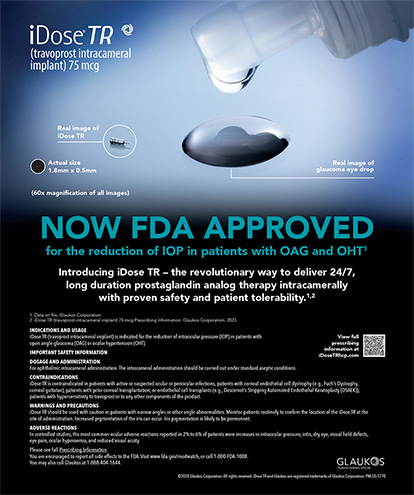Restasis, the dry eye treatment by Allergan, Inc. (Irvine, CA), that recently gained FDA approval, was originally developed as an antifungal agent. Produced from the fungus Tolypocladium inflatum gams, the drug eventually demonstrated profound effects against T-cell lymphocytes. An ophthalmic emulsion of 0.05% cyclosporine, Restasis works by inhibiting the activation of these lymphocytes, thereby preventing cytokines and other inflammatory agents from bathing the ocular surface. It blocks cyclophilin, a central enzyme in the activation of T-cell lymphocytes. By preventing this activation, the oral form of Restasis greatly helps to improve the success of solid organ transplantation. In fact, it is the primary drug used in solid organ transplantation procedures throughout the world.
FIRST OPHTHALMIC APPLICATIONS
During the drug's development, researchers noted that certain patients who were treated with the oral form of Restasis, such as kidney and rheumatoid arthritis patients, who also suffered from dry eyes, experienced an improvement in their dry eye disease in addition to their kidney and joint disease. Based on these findings, cyclosporine was used in research involving beagles, which have a propensity toward keratoconjunctivitis sicca, a dry eye condition also found in humans. The results were dramatic; the dogs were virtually cured of the disease. Subsequently, topical cyclosporine A was approved in 1995 for use in veterinary medicine in the US.
The lengthiness of human studies delayed Restasis' FDA approval for medical usage in humans until December 23, 2002. Despite this delay, however, many clinicians have been using topical cyclosporine for a number of diseases that commonly share T-cell activation as a primary component of their etiology. Such diseases include Thygeson's disease, superior limbic keratoconjunctivitis, and Mooren's ulcer. Practitioners have also used the drug in adjunctive therapy in mycotic keratitis.
PROVEN EFFICACY
The FDA study of 877 patients targeted those with severe dry eye disease, particularly Sjögren's syndrome, a condition suffered by 31% of the study subjects. Research-ers divided this patient group into three subgroups, one receiving cyclosporine at 0.05%, the second receiving it at 0.1%, and the third (control) receiving the vehicle alone for 6 months before switching to cyclopsporine 0.1% for the final 6 months of the study. Both groups experienced statistically significant improvement in their dry eye symptoms compared with the control group (Figures 1A and B and 2A and B). Interestingly, a new artificial tear substance with which the control group was treated, designed as a carrier of the Restasis drug, proved to be a superb vehicle. In our opinion, this substance, Refresh Endura (Allergan, Inc.), is probably the best artificial tear product made to date.
The speed with which Restasis achieved statistical significance in this study illustrates this drug's effectiveness and mode of action. Because its mechanism of action is to inhibit T-cell lymphocytes, and the normal life span of a lymphocyte is 110 days, we would expect the drug to take at least 3 months to show efficacy. In the phase III trials, we noticed significant effects by 3 months that continued to improve at the 6-month evaluation.
In the dry eye state, the inflamed lacrimal gland secretes tears that are rich in cytokines and lymphokines, which stimulate further inflammatory responses in the conjunctiva and over the entire ocular surface. This increased inflammation induces a denervation—a decrease in the response to touch stimuli—resulting in decreased nervous impulses traveling to the brain. Consequently, fewer responses travel from the brain to the lacrimal gland, thereby decreasing tear flow and increasing inflammation. These reactions explain why patients with significant dry eye disease progressively worsen with time. Restasis inhibits this cycle, enabling the T-cell lymphocytes to be cleared from the lacrimal gland and allowing the affected tissues to restore themselves. In this way, Restasis is the first treatment that can treat the root cause of dry eye disease. In patients who respond favorably, it is a very dramatic event indeed: they can improve from severely affected to almost asymptomatic within 6 months.
CONCLUSION
For physicians unfamiliar with Restasis, we recommend first using it in patients who have significant dry eye disease in order to gain experience with its efficacy. Because these patients would otherwise continue to deteriorate with time, it is very satisfying to treat them with this agent.
Eric D. Donnenfeld, MD, is a partner in Ophthalmic Consultants of Long Island, and is Co-Chairman of Corneal and External Disease at the Manhattan Eye, Ear and Throat Hospital in New York. He holds no financial interest in any product discussed herein. Dr. Donnenfeld may be reached at (516) 766-2519; eddoph@aol.com.


